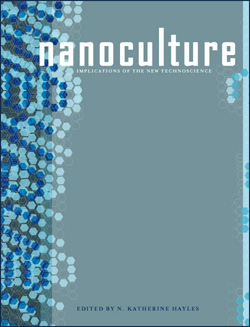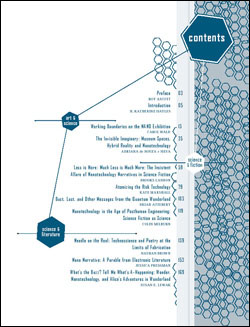NanoCulture: The New Technoscience and its Implications for Literature, Art, and Society,
Edited by N. Katherine Hayles
(90,000 words with 32 color illustrations. Forthcoming April 2004, Intellect Books. Preface by Roy Ascott)
A pioneering work, Nanoculture is the first book-length critical study of the relation of nano-technoscience to literature, art, and culture. NanoCulture transverses disciplinary boundaries to explore the intricate and complex ways in which nano-technoscience becomes a cultural production and the modes by which culture appropriates and transforms what the technoscience means. The book is published in collaboration with the Nano exhibit, opening in December 2003 at the Los Angeles County Museum of Art and created by an interdisciplinary team of artists, scientists, and humanists led by Victoria Vesna, James Gimzewski, and Katherine Hayles in a setting designed by the architectural firm of Sharon Johnston and Mark Lee.
Exploring the relation of the Nano exhibit to changing concepts of museum space is Adriana de Souza e Silva's "The Invisible Imaginary: Museum Spaces, Hybrid Reality and Nanotechnology." Carol Wald's "Working Boundaries on the Nano Exhibition" is an ethnographic analysis of the process of creating the exhibit and its implication for collaborative process.
Another group of essays explores the relation between nano-technoscience and science fiction. Colin Milburn in "Nanotechnology in the Age of Posthuman Engineering: Science Fiction as Fiction" argues that nanoscience, in establishing its legitimacy, both embraces and rejects science fiction, its complementary other. Brooks Landon in "Less is More: Much Less is Much More: The Insistent Allure of Nanotechnology Narratives in Science Fiction" suggests why nanotechnology uniquely fulfills the requirements of "science fiction thinking." Kate Marshall in "Atomizing the Risk Technology" observes that nanotechnology is mostly a technology of the future and relates this temporality to the technology of risk assessment and reflexive modernity. In "Dust, Lust, and Other Messages from the Quantum Wonderland," Brian Attebery argues that nanobots are not only creations of the future; they are already us.
A final group of essays explores relations between nano-technoscience and literature. In "Needle on the Real: Technoscience and Poetry at the Limits of Fabrication," Nathan Brown argues that the scanning tunneling microscope can be understood as a writing instrument and relates its techniques to the ethical and artistic explorations of poets who also work at the "limits of fabrication." Jessica Pressman in "Nano Narrative: A Parable from Electronic Literature" argues that narrative is essential to the emerging field of nanotechnology and shows its influence in Erik Loyer's Chroma. Susan Lewak in "What's the Buzz? Tell me What's A-Happening: Wonder, Nanotechnology, and Alice's Adventures in Wonderland" identifies wonder as a central component of nanotechnology's popular appeal and relates its focus on scale to Alice in Wonderland. Together, these essays demonstrate that nanotechnology does not stand above culture but rather is deeply implicated in cultural processes and significations; it also shows that contemporary culture is increasingly understanding its future and therefore its present in terms of this powerful new technology.



